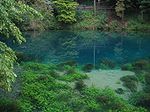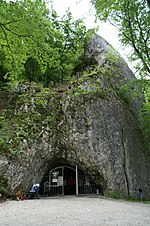Brillenhöhle
Archaeological sites in GermanyCave bearCaves of GermanyLandforms of Baden-WürttembergUpper Paleolithic sites in Europe

The Brillenhöhle (German: Brillenhöhle, literally spectacles cave) is a cave ruin, located 16 km (9.94 mi) west of Ulm on the Swabian Alb in south-western Germany, where archaeological excavations have documented human habitation since as early as 30,000 years ago. Excavated by Gustav Riek from 1955 to 1963, the cave's Upper Paleolithic layers contain a sequence of Aurignacian, Gravettian and Magdalenian artifacts. In 1956 the first human fossils were discovered within a fireplace in the center of the cave, a discovery which made important contributions to the foundational understanding of the Magdalenian culture of central Europe.
Excerpt from the Wikipedia article Brillenhöhle (License: CC BY-SA 3.0, Authors, Images).Brillenhöhle
Weilerhalde, Gemeindeverwaltungsverband Blaubeuren
Geographical coordinates (GPS) Address External links Nearby Places Show on map
Geographical coordinates (GPS)
| Latitude | Longitude |
|---|---|
| N 48.405555555556 ° | E 9.7777777777778 ° |
Address
Brillenhöhle
Weilerhalde
89143 Gemeindeverwaltungsverband Blaubeuren
Baden-Württemberg, Germany
Open on Google Maps










